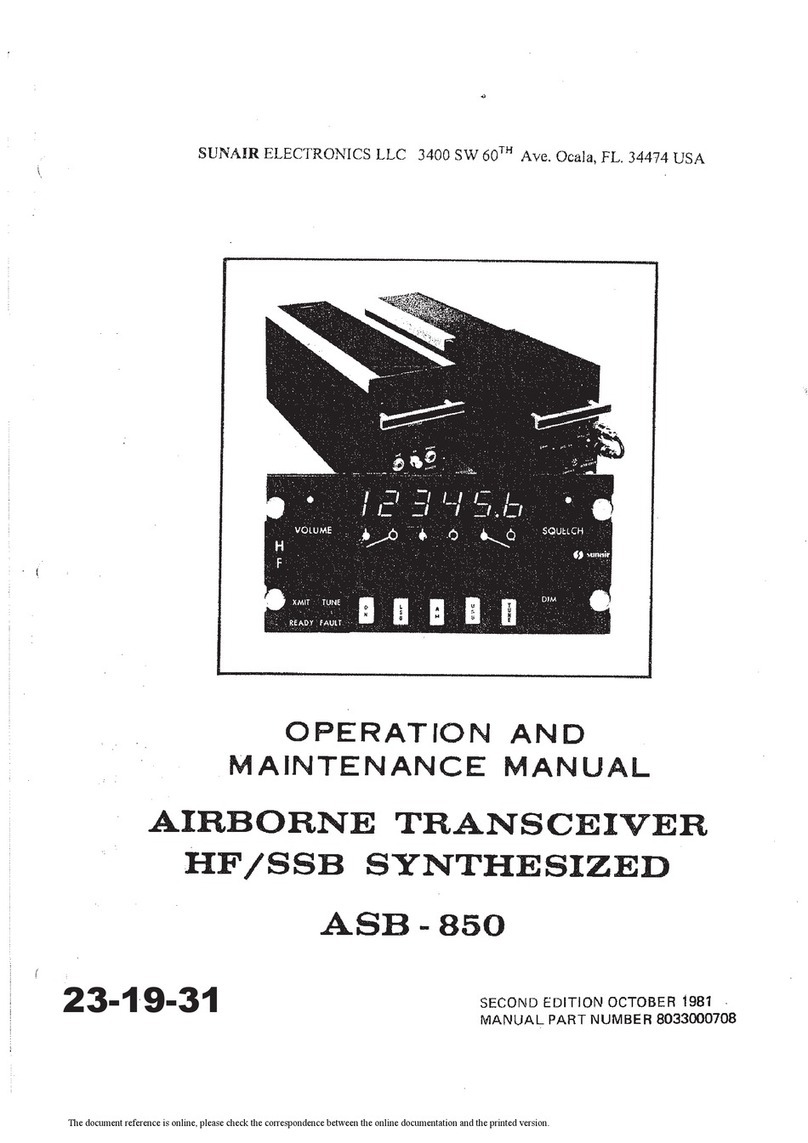
what is best for one parameter
is
not
best for
another. The
HF
antenna is no exception. What
sometimes occurs
is
that the length, shape (con-
figuration) and location of the iIntenna on an air-
craft is something very visible and these factors
receive tlie major consideration. The cornmunica-
tions performance of tile antenna is not readily
apparent or known. partic~~larlyat the time of
installation and decisions are made regarding the
antenna installation which later prove to be bad
for system operation. The solution tlien
is
to
select an antenna that does not overly favor any
factor to the detrement of the other factors.
2.8.2
FACTORS TO
BE
CONSIDERED
In order to select the best antenna, consideration
must
be given to the following factors:
I.
Type of aircraft
a.
Size. shape, airspeed
2.
Required con~rnunioationsrange
3.
Transmitter frequencies
4.
Antenna flight requirements
5.
Possible antenna coupler locations
6.
Antenna radiatiori ckaracteristics.
Aircraft size and shape is important as
it
mily re-
strict the types ot possible antennas. Aircraft
speed must be considered. as
160
MPH
and faster
type of aircraft cannot generally i~sc
a
wing tip
attached
V
antenna. This type
OF
aircraft rnay also
operate in icing conditions which adversely affect
V
antennas more than t11c straight type.
The end users commu~iicationsdist;lncr retluire-
ments must be considered, particularly if long runge
such as
800
rniles and greater is reqttired
on
freq~~enciosas low as
0
to
8
MHz.
This would re-
quire a
V
antenna or
a
long
straight antenna
35
feet
or longer,
if
ungrounded.
Transmitter freqi~encies
arc
getlerully determined
by the area of operation and statiotls to be worked.
These in turn can affect the aritenlla selection. If
most of the freqi~e~iciesare
above
5
MHz
it
is
possible to use
a
shorter or srraiglit atitrn~iaas
coi~plerefficiency above
5
MHz
is good regardless
of the antenna type.
The antenna uerodyt~arnicrerluirrmc.~itsare related
to the aircraft type and operating capabilities.
Generally tlie best aerodyt~aniicdesig~ires~~ltsin
the poorest radiating Jntenna when consiclering
only ungroi~ndedantennas. and care must be
taken here
in
order not to dcgratle the systen?
operation.
The antenna coupler locatioti ~fictatcsthe location
of one end of the atiterinn.
Thc
oi~tp~~tof the
coupler is the beg~nning
ut'
[Izc
antenna and the
antenna wire inside thc aircraft rni~stbe restrict-
ed
in
Iengtli, iclenlly
not
more than
h
inches to a
maximum of 12 inc.hes. i~nlcsscoax teed
is
used
for the antenna.
The antenna radiation cllaractrristics
(tlow
well
does
it
radiate or receive
;I
signal)
IS
gr~ierallythe
hardest to cletermine.
It
is always best
to
install
a11 antenna that has prove!) to pertorm well in
past installatiotls. The atltennas sl~ownoti the fol-
lowing pages Iiave all
brcn
installetl atid used wit11
success on varivi~saircratt. Some w~llwork better
on one type of aircraft than another, particular-
ly
the grounded
type.
The grounded
antenna
to
the
engine nacelle or vertical stabilizer has worked
well
on
many differetlt ;lircraft It m:ly
be
1iect.s-
sary to try several locations nncl
types
ot
antennas
it1
order to satisfy all ot thc. tactors outliner1 Ilere
itnd not overly comproniist. ally o~iefi~ct~r
The document reference is online, please check the correspondence between the online documentation and the printed version.


































